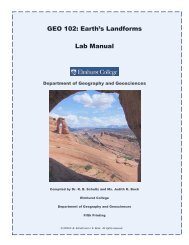Construction of an Anaerobic Gassing Station to ... - Elmhurst College
Construction of an Anaerobic Gassing Station to ... - Elmhurst College
Construction of an Anaerobic Gassing Station to ... - Elmhurst College
Create successful ePaper yourself
Turn your PDF publications into a flip-book with our unique Google optimized e-Paper software.
I. Project Summary<br />
Marsh, T. L. 2 <strong>of</strong> 7<br />
Chromium is a unique element, functioning as both <strong>an</strong> essential micronutrient <strong>an</strong>d a<br />
carcinogen depending on the valence state. Hexavalent chromium [Cr(VI)] is<br />
carcinogenic, mutagenic, <strong>an</strong>d readily soluble in water, allowing it <strong>to</strong> move easily in<br />
aquatic environments. M<strong>an</strong>y industrial processes are known <strong>to</strong> generate large<br />
qu<strong>an</strong>tities <strong>of</strong> Cr(VI)-laden wastewater which must be treated before release. On the<br />
other h<strong>an</strong>d, trivalent chromium is necessary for functioning <strong>of</strong> <strong>an</strong>imal cells, 100-fold<br />
less <strong>to</strong>xic th<strong>an</strong> the hexavalent form, <strong>an</strong>d is nearly insoluble in water. Thus,<br />
conversion <strong>of</strong> the hexavalent form <strong>to</strong> the trivalent is a satisfac<strong>to</strong>ry treatment strategy.<br />
Current treatments bring about a chemical reduction but are costly <strong>an</strong>d create other<br />
forms <strong>of</strong> waste. Finding a biological system <strong>to</strong> catalyze hexavalent chromium<br />
reduction presents <strong>an</strong> economical alternative <strong>to</strong> current regimes. This requires a<br />
deeper knowledge <strong>of</strong> the biochemistry <strong>of</strong> the org<strong>an</strong>isms capable <strong>of</strong> these reactions,<br />
a knowledge which is currently unavailable.<br />
Org<strong>an</strong>isms <strong>of</strong> import<strong>an</strong>ce in contaminated ecosystems would likely be categorized<br />
as strictly <strong>an</strong>aerobic, growing only in the absence <strong>of</strong> molecular oxygen. Cultivation<br />
<strong>of</strong> such org<strong>an</strong>isms would require the use <strong>of</strong> <strong>an</strong> <strong>an</strong>aerobic gassing station <strong>to</strong> remove<br />
all oxygen molecules from gases <strong>an</strong>d materials which might come in<strong>to</strong> contact with<br />
microbial cultures. After construction <strong>of</strong> the gassing station is completed it will be<br />
essential in techniques used <strong>to</strong> study <strong>an</strong>aerobic org<strong>an</strong>isms such as Cr(VI)-reducing<br />
or meth<strong>an</strong>ogenic. This funding will allow the purchase <strong>of</strong> parts <strong>an</strong>d equipment <strong>to</strong><br />
construct such a system making it possible <strong>to</strong> begin a research program in<br />
<strong>an</strong>aerobic microbiology at <strong>Elmhurst</strong> <strong>College</strong>.<br />
II. Narrative<br />
1. Current Situation<br />
Industrial practices including electroplating, leather t<strong>an</strong>ning, pigment m<strong>an</strong>ufacture,<br />
corrosion inhibition, <strong>an</strong>d fungicide production generate large qu<strong>an</strong>tities <strong>of</strong> chromiumladen<br />
wastewater, which must be treated before discharge. About 170,000 <strong>to</strong>ns <strong>of</strong><br />
chromium wastes are released in<strong>to</strong> the environment <strong>an</strong>nually. The widespread use<br />
<strong>of</strong> chromium as well as the improper disposal <strong>of</strong> chromium-laden wastes has led <strong>to</strong><br />
areas <strong>of</strong> serious environmental contamination. The prevalence <strong>of</strong> chromium<br />
contamination has resulted in the classification <strong>of</strong> chromium as one <strong>of</strong> the seventeen<br />
most import<strong>an</strong>t environmental <strong>to</strong>xic<strong>an</strong>ts by the U.S. Environmental Protection<br />
Agency.<br />
Chromium exists in oxidation states r<strong>an</strong>ging from 0 <strong>to</strong> +6, although, only two states,<br />
Cr(III) <strong>an</strong>d Cr(VI), are commonly observed in environmental samples. The valence<br />
state <strong>an</strong>d relative solubility <strong>of</strong> chromium are dependent on environmental conditions<br />
(pH, temperature, redox potential) <strong>an</strong>d the presence <strong>of</strong> other org<strong>an</strong>ic <strong>an</strong>d inorg<strong>an</strong>ic<br />
molecules. Trivalent chromium, or Cr(III), <strong>an</strong> essential trace nutrient in the hum<strong>an</strong><br />
diet, has relatively low <strong>to</strong>xicity <strong>an</strong>d is nearly insoluble at neutral pH, <strong>an</strong>d thus, nearly<br />
immobile in the environment. Conversely, hexavalent chromium, or Cr(VI) is acutely












